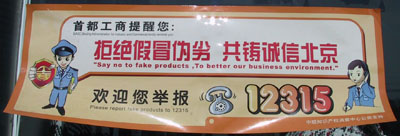Replicants
Today I spent many hours of hell braving the Ya Show market in central Beijing. Armed with printouts of fine handbags from my wife I was there to acquire as many name-brand knock-off purses as I could afford and carry back to the hotel without undue strain or attention being drawn. It was misery, since I’m not a big shopper anyway and have no innate sense of what a Prada purse should cost, but I made it out relatively unscathed. Two things made me laugh repeatedly, though. The English of the stall-keepers was uniformly horrible, unless it related directly to the act of selling or keeping you from walking away. Phrases such as “make me a smarter offer” or “where will you find such quality elsewhere?” were syntactically correct and enunciated flawlessly. It was fun to test the boundaries, to probe the limits of vendors who were really just human phrase-recall databases.
Input: potential buyer walking away.
Output: “Sir, please enter your price into my calculator.”
Input: Shopper says “Do you take US dollars?”
Output: “Why yes, sir, as well as RMB and Hong Kong dollars, thank you.”
Input: Shopper says “Excuse me, do you know the closet subway line to the market?”
Output: Blank stare, no keywords triggered. Abort, retry, fail?
The other thing I loved were the signs placed everywhere imploring shoppers to report any fake products. It was all so earnestly ridiculous. There wasn’t anything real in the whole place. (Not that I could have spotted a real Gucci purse, mind you.) Sure, I’ll dial the police right up. Just let me know if the American embassy will pay for my funeral after the shopkeepers — and their customers! — lynch me with so many faux leather belts.
True, in advance of the Olympics and as part of playing nicely with their trading partners, the Chinese authorities are starting to crack down on the product replica business, but I think this may not ultimately be as much an economic practice as a cultural one.
In his fascinating book The Future of the Past, Alexander Stille notes how China and other Asian countries do not consider a copy to be less real or less significant than the original it represents. Like a digital copy of a file that has no more claim to authenticity than its “source” file, high-quality copies in China are consider artforms in their own right. This is borne out in the field of cultural artifact conservation. For the Chinese, copying is conservation, a concept completely foreign to Western conservators. Because most Chinese architecture had traditionally been wood-based (rather than stone-based) there has never been a strong notion of permanence in art. To keep a work of art alive you had to replicate it and, in the process, were showing a reverence for the skill of the artisan that came before you. Still, this approach flies in the face of nearly every precept of Western cultural conservation. Can you imagine the Italians throwing out the David and creating a new, cleaner one as a solution to the recent conversation problems they have had?
It will be a shame if the fake product industry (or the skills upon which it thrives) does not survive in the face of globalization and homogenizing markets. In a way, the closure of the fake product markets is just the latest assault on the “culture of the copy,” as Stille terms it. Just as the Cultural Revolution decimated sites of historical value throughout China — effectively severing the centuries-old artisanal traditions that permitted the cycle of upkeep and re-creation to persist — the closure of markets like the famous Silk Alley represents the triumph of one concept, in this case the inviolability of global trademarks, over another, much older one: the exultation of the replica.














